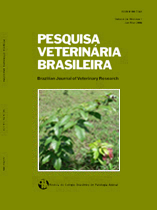 |
|
|
|
Year 2009 - Volume 29, Number 07
|

|
Polioencefalomalacia em bovinos: epidemiologia, sinais clínicos e distribuição das lesões no encéfalo, p.487-497
|
ABSTRACT.- Sant’Ana F.J.F., Rissi D.R., Lucena R.B., Lemos R.A.A., Nogueira A.P.A. & Barros C.S.L. 2009. [Bovine polioencephalomalacia: epidemiology, clinical signs and distribution of lesions in the brain.] Polioencefalomalacia em bovinos: epidemiologia, sinais clínicos e distribuição das lesões no encéfalo. Pesquisa Veterinária Brasileira 29(7):487-497. Departamento de Patologia, Universidade Federal de Santa Maria, 97105-900, Santa Maria, RS, Brazil. E-mail: claudioslbarros@uol.com.br
Thirty one cases of polioencephalomalacia (PEM) diagnosed from 1999-2008 in cattle from the Southern (13 cases) and Midwestern (18 cases) Brazil were studied. Morbidity (0.04%-6.66 %), mortality (0.04%-6.66 %), and lethality (50%-100%) rates were similar in both regions studied. There was no clear association between PEM cases and age, sex or seasonality. Cases occurred mainly in cattle raised at pasture; in the Southern the disease affected mainly young cattle (one-year old or less) while mainly older cattle (three-year-old or older) were affected in the Midwest. Clinical signs more frequently observed included blindness, incoordination, circling, opisthotonus, recumbence and peddling movements. Clinical course varied from 12 hours to 8 days (average three days and a half). In 11 cases no gross changes were observed in the brain. Main gross findings in the brain of remaining cases included congestion with swelling and flattening of gyri, softening and yellow discoloration of cerebral cortex, hemorrhagic foci in the brain stem, cerebellum and telencephalon, and cerebellar herniation. The main histopathological changes were in the cortex of occipital, parietal and frontal telencephalic lobes; however less prominent and less frequently found lesions occurred in the hippocampus, basal nuclei, thalamus, midbrain, and cerebellum. The type of microscopic cortical lesions was consistent in all cases and included segmentar laminar neuronal necrosis (red neurons), spongiosis, swollen of vascular endothelial nuclei, Alzheimer type II astrocytes and infiltration of gitter cells. In 20% of the cases there was mild lymphohistiocytic cellular infiltrate and in 13% of the cases there was mild infiltrate by neutrophils and eosinophils. Additionally, mild to moderate necro-hemorrhagic lesions were observed in 49% of the cases in the basal nuclei, in 39% of the cases in brain stem and in 26% of the cases in the thalamus. Brain lesions were consistently found in the cortical laminae of the occipital, parietal and frontal telencephalic lobes. In such locations, most frequently affected cortical layers both by neuronal necrosis and edema were external and internal granular layers. Both gyri and sulci were equally affected. |
| |
|
|
| |
|
 |